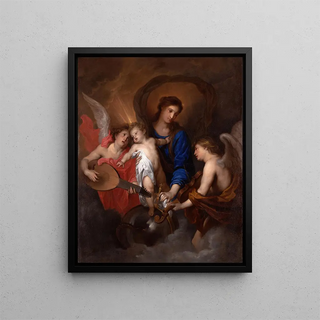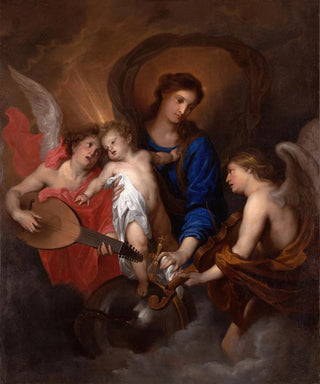Art print of the Virgin and Child with Musicians Angels - Antoine van Dyck | Art print


View from behind

Frame (optional)
The "Virgin and Child with Musicians Angels" by Antoine van Dyck is a piece that transports the viewer into a universe filled with tenderness and spirituality. Painted in the 17th century, this iconic work demonstrates technical mastery and palpable emotion that characterize the work of this Flemish artist. The artwork, with its harmonious composition and angelic figures, evokes an atmosphere of divine serenity. Through this representation, Van Dyck invites deep contemplation, where the gaze is lost in meticulous details and delicate expressions of the characters. This art print allows for rediscovering the very essence of the original work, while offering an entry point into the fascinating world of Baroque painting.
Style and uniqueness of the work
Van Dyck's style is distinguished by refined elegance and a subtle use of light, which gives his characters an almost lifelike dimension. In "Virgin and Child with Musicians Angels," the color palette chosen by the artist evokes the softness of the scene, where pastel shades blend harmoniously. The angels, delicately depicted, seem to play a celestial melody that resonates beyond the painting. The composition is carefully balanced, with the Virgin and Child at the center, surrounded by angelic musicians, creating a captivating visual dynamic. Every detail, from the drapery of the clothing to the expressions on the faces, testifies to Van Dyck's skill in capturing human emotion and spiritual beauty.
The artist and his influence
Antoine van Dyck, a pupil of Rubens, established himself as one of the greatest portraitists of his time. His career, marked by stays at the English court, profoundly influenced the European artistic landscape. Van Dyck was able to combine Flemish tradition with Italian sensibility, thus enriching his personal style. His works, often imbued with nobility and dignity, inspired many artists who followed him. By depicting sacred figures with such humanity, he redefined religious portraiture, making it accessible and

Matte finish

View from behind

Frame (optional)
The "Virgin and Child with Musicians Angels" by Antoine van Dyck is a piece that transports the viewer into a universe filled with tenderness and spirituality. Painted in the 17th century, this iconic work demonstrates technical mastery and palpable emotion that characterize the work of this Flemish artist. The artwork, with its harmonious composition and angelic figures, evokes an atmosphere of divine serenity. Through this representation, Van Dyck invites deep contemplation, where the gaze is lost in meticulous details and delicate expressions of the characters. This art print allows for rediscovering the very essence of the original work, while offering an entry point into the fascinating world of Baroque painting.
Style and uniqueness of the work
Van Dyck's style is distinguished by refined elegance and a subtle use of light, which gives his characters an almost lifelike dimension. In "Virgin and Child with Musicians Angels," the color palette chosen by the artist evokes the softness of the scene, where pastel shades blend harmoniously. The angels, delicately depicted, seem to play a celestial melody that resonates beyond the painting. The composition is carefully balanced, with the Virgin and Child at the center, surrounded by angelic musicians, creating a captivating visual dynamic. Every detail, from the drapery of the clothing to the expressions on the faces, testifies to Van Dyck's skill in capturing human emotion and spiritual beauty.
The artist and his influence
Antoine van Dyck, a pupil of Rubens, established himself as one of the greatest portraitists of his time. His career, marked by stays at the English court, profoundly influenced the European artistic landscape. Van Dyck was able to combine Flemish tradition with Italian sensibility, thus enriching his personal style. His works, often imbued with nobility and dignity, inspired many artists who followed him. By depicting sacred figures with such humanity, he redefined religious portraiture, making it accessible and
12,34 €






